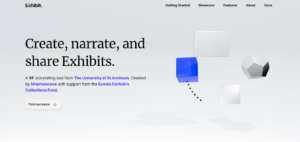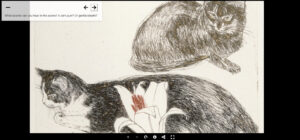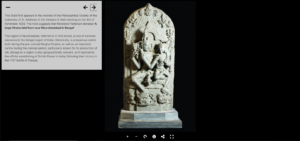Digital Engagement With Collections at the Museums of the University of St Andrews
Sophie Lenihan and Lydia Heeley are currently leading on the project “Online Storytelling with Museum Collections” at Museums of the University of St Andrews, funded by the Esmee Fairbairn Collections Fund. In this blog they talk to us about developing Exhibit, a tool for digital engagement with the museum’s collection.
In May of 2020 the University of St Andrews realised that they needed to rapidly develop their resources to facilitate online teaching. Regardless of the outcome of the initial lockdown of 2020 it was clear that the 2020/2021 academic year was going to be far from the normal teaching experience.

In partnership with Mnemoscence, the Museums of the University of St Andrews have developed a tool, Exhibit, which allows students to engage virtually with one of our most valuable teaching resources, the University’s museum collection. Ranging from contemporary Scottish art to historic zoology specimens, the museum collection remains a key teaching resource for many subjects on offer.
The precursor to the tool has been a rapid digitisation project. With funding from the Esmée Fairbairn Collection Fund, it has allowed for a dedicated team of digitisers to begin the digitisation of a complicated collection and to update our digital offer with 2D and 3D imagery. It has also required a huge combined effort between Museums and IT Services to get our online collection compatible with The International Image Interoperability Framework (IIIF). Once a digital file is IIIF enabled it can be used in Exhibit.
Exhibit has been designed for objects to be presented and viewed with a focus on the narrative. Encouraging users to create, annotate and share, the “zoom and describe” function offers a new way to highlight aspects of an object which can get overlooked in traditional methods of interaction and display. The tool has been piloted in the Autumn of 2020 and has already been used as a new way to deliver lectures and assessment in the University.
However, Museums of the University of St Andrews recognised the potential Exhibit had – not only to benefit our staff and students, but all our wider museum audiences. This tool is not a formal and academic resource, it provides members of our community with a new way to engage with collections online.
At Museums of the University of St Andrews, we have used the Exhibit tool in our social media to keep the collections accessible while access to our museum spaces are restricted. At a time where virtual museum experiences have become the norm, it has allowed the team to explore objects in new and creative ways, keeping our digital offer fresh in our online campaigns- including highlights of our Recording Scotland Collection and Boswell Collection.
In our programming, Exhibit has provided a new way to facilitate events. In our wellbeing strand Headspace, the “zoom and describe” has been used to create interactive mindfulness experiences with art. By highlighting aspects of the pieces, the viewer is encouraged to take time out from work to be guided through a piece. Prompts encourage them to not simply view the piece in the two dimensional, but to use their imagination to invoke what sights, smells and sounds might be present beyond the borders of the artwork.

In our series “Critical Conversations” the tool has been used to highlight an object at each event which stands as an example of a “critical conversation” which needs to be had in museums. This has included issues of museum collecting, colonial histories, difficult legacies and representation of community voices in museums. Using Exhibit, we provided a platform for participants to independently explore the highlighted object, and for panellists to develop their own narrative for objects prior to the events. This included a fresh insight from our BAME Officer, Ananya Jain, into a Stone Stele to be displayed in the new Wardlaw Museum.

We have further aspirations for the Exhibit tool to be used by pupils in our upcoming schools programme, and even a virtual room escape game to complement our exhibitions programming. As we have done in Museums of the University of St Andrews, we hope people using Exhibit will think of new, creative ways in which the tool can facilitate virtual experiences of their collections.
As an open resource, the exhibit tool is now available for anyone – museum staff, students, parents and teachers – to create exhibits using IIIF enabled collections. The IIIF community includes internationally known collections, from the British Museum to the Vatican Library.
The Exhibit tool and digitisation project have helped to kickstart a new wave of interest in our collections and emphasise the importance of integrating digitisation into everyday workflows. The year of 2020, and the events within it, have demonstrated worldwide that digital is no longer a nice addition to a museum’s offer, but has become a vital resource in the accessibility of a collection.
It is our hope that, due to tools such as Exhibit, we can demonstrate the wide-reaching impact of such projects within museums, and prove they should no longer be seen as a fix for an unfortunate circumstance but an integral part of their offer, which is worthy of continued investment and development.
More Information:
View Exhibit main page.